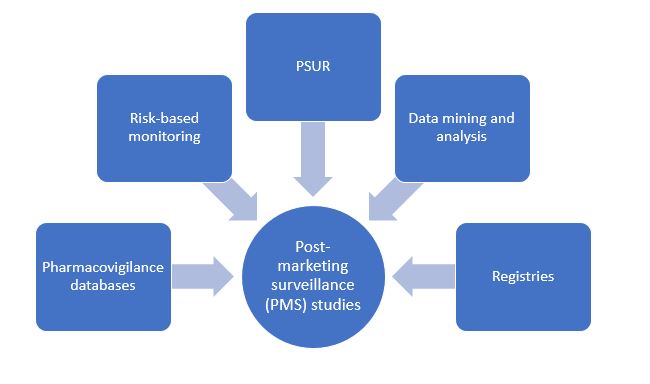Although clinical trials provide useful information regarding the efficacy and safety of new drugs, biological products, and medical devices, the information captured through them is not all-encompassing. Limited patient populations, controlled and strict conditions treatment regimens, adherence protocols, limited duration and indications for use, and continuous monitoring of participants by healthcare professionals is not reflective of the real-world scenario once the product is approved and on the market. Post-marketing surveillance (PMS) studies refer to the monitoring of drugs once they reach the market after clinical trials and help to capture previously undetected or unexpected safety concerns that can threaten patient health. Additionally, PMS studies can also help positive effects of a drug in conditions not studied in clinical trials. Historical events such as the thalidomide tragedy that led to birth defects in children of women taking the drug for sleeplessness, anxiety, and morning sickness have supported the use of PMS studies. Therefore, it is necessary for manufacturers and sponsors must develop a robust PMS program which is also required as part of Phase IV studies by regulatory authorities and a component of risk management plan.
PMS studies result in appropriate action to improve patient safety which includes changes in product labelling (dose regimen, interactions, adverse effects), product withdrawal from the market, or restricted use in certain patient populations (paediatrics or geriatrics). These changes can be instituted voluntarily by drug companies or forced upon by regulatory authorities, surveillance organizations, consumer advocacy groups, and specialist commentators. However, the overarching goal of all PMS studies is to ensure the safety of drugs and medical devices and to ensure that appropriate actions are undertaken if the risk of continued use outweighs the benefit.
The various PMS strategies are as follows
Pharmacovigilance databases and programs
The FDA Adverse Event Reporting System (FAERS) is a database that contains adverse event and medication error reports, and product quality complaints that are voluntarily reported to the FDA by healthcare professionals or consumers. Clinical reviewers at the FDA evaluate and analyse the reports sent and make recommendations on the safety of the product. MedWatch is FDA’s program for mandatory and voluntary reporting of prescription medications, over-the-counter (OTC) products, and biologicals, and medical devices to the FAERS database and is responsible for the publication of safety alerts for FDA-regulated products. The FDA’s Sentinel initiative is an active post-market surveillance program that analyses safety data from real-world sources such as electronic health records (EHRs), insurance claims, registries, and pharmacy records. The Sentil system involves the contribution of several organizations that analyse the data and make decisions on action to be taken which can involve investigations and regulatory updates. In India, the Pharmacovigilance Program of India (PvPI) which is an Indian government organization is responsible for the identification of safety concerns and appropriate responses to protect patient health.
Risk-based monitoring
It is important to develop a risk management plan commensurate with the risk category of a drug or medical device throughout the product lifecycle to identify and remedy potential safety risks. This strategy involves a continuous collection of safety information, evaluation of risk-benefit profile, and timely and comprehensive risk communication to healthcare professionals and consumers regarding safety issues.
Data mining and analysis
Data mining and statistical analysis techniques are a crucial part of PMS studies as pharmacovigilance databases contain data in different formats and standards from sources such as clinical trials or spontaneous reports. Decoding, cleaning, and normalization of data sets is important to extract meaningful information about safety concerns. Disproportionality analysis, Bayesian data mining, and machine learning (ML) are used to analyse safety signals and their severity and are performed on an ongoing basis to ensure product safety throughout the lifecycle.
Periodic Safety Update Report (PSUR)
PSURs are pharmacovigilance documents that provide an evaluation of risk-benefit balance of a pharmaceutical product/medical device at defined time points after its authorization or approval by regulatory agencies. It contains detailed information on the adverse events, patient populations, relevant literature, and previous regulatory actions. They allow for timely detection of adverse events and allows for the development of risk mitigation strategies.
Registry programs
Disease and product registries provide surveillance for a broad patient population which is inclusive of gender, age, and comorbidities and provides information of prescription patterns and off-label uses and serve as an important source of real-world data (RWD).
Thus, PMS studies are as important as clinical trials which are used to obtain regulatory approval for new drugs and medical devices. Integrating data from various types of PMS studies is critical and is monitoring the safety of the drug on a continuous basis to allow for prompt regulatory actions that can help prevent major adverse events that can jeopardize patient health.
References
- Postmarketing Surveillance – an overview | ScienceDirect Topics
- Guidance for post-market surveillance and market surveillance of medical devices, including in vitro diagnostics (who.int)
- FDA’s Sentinel Initiative – Background | FDA
- MedWatch: The FDA Safety Information and Adverse Event Reporting Program | FDA
- Pharmacovigilance Programme of India (ipc.gov.in)
- Post-marketing Drug Safety Evaluation using Data Mining Based on FAERS – PMC (nih.gov)
- Use of Registries in Product Safety Assessment – Registries for Evaluating Patient Outcomes – NCBI Bookshelf (nih.gov)






